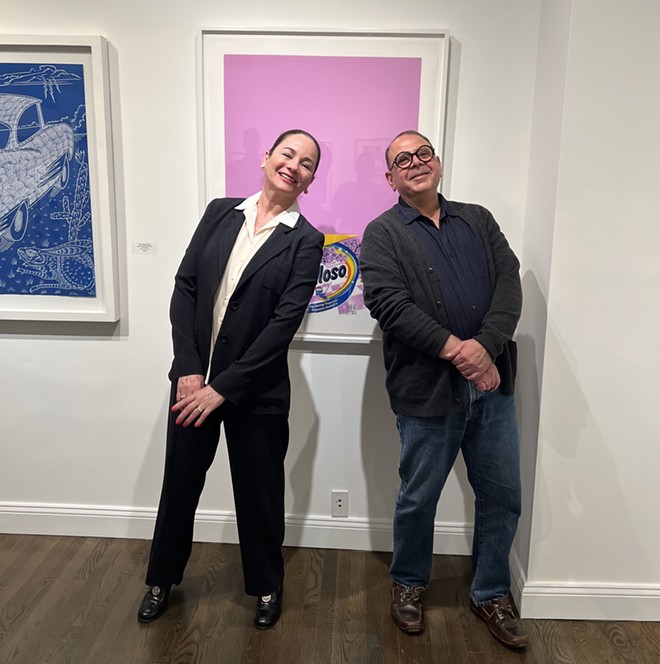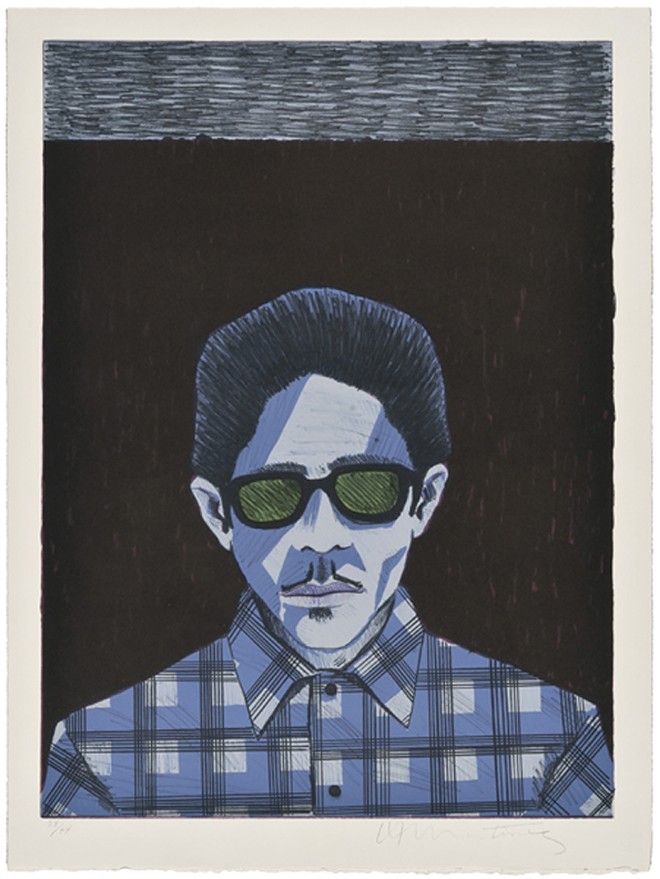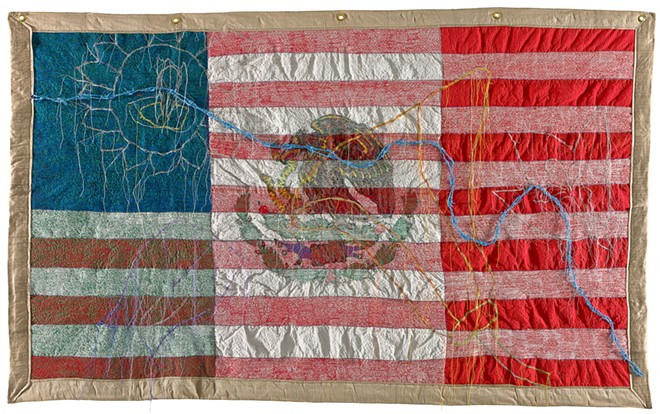
Raised on a ranch in Sonora, Mexico, Patricia Ruiz-Healy developed a fondness for books around the age of 4.
"I was a little nerd growing up," she admitted. "And growing up on a ranch, there are not a lot of books."
While studying English in London just after high school, Ruiz-Healy experienced a lightbulb moment at the Courtald Museum. Gazing at Édouard Manet's mysterious 1882 painting A Bar at the Folies-Bergère, she realized she wanted to study art history.
That pivotal discovery sparked Ruiz-Healy to earn numerous degrees, the most recent being a Ph. D. in Latin American studies — with an unsurprising concentration in art history — from the University of Texas at Austin in 2017.
A San Antonio fixture since the 1990s, Ruiz-Healy turned her passion into a business in 2006 by establishing Ruiz-Healy Art — an Olmos Park gallery dedicated to showcasing Latin American, Latinx and South Texas artists. In 2019, she expanded her scope by opening a New York City gallery that frequently places San Antonio artists on a global platform. Beyond her gallery program, Ruiz-Healy is the exclusive representative of the estate of Chuck Ramirez, a late local legend who left indelible impressions on his native San Antonio.
We recently caught up with Ruiz-Healy to chat about recent exhibitions at both her galleries, her experience at New York's renowned Armory Show, and her forthcoming fall showcase for California-based textile artist Consuelo Jimenez Underwood.
Repping San Antonio in New York
Situated on Manhattan's Upper East Side, Ruiz-Healy's New York gallery has done San Antonio proud since day one, opening its doors with a photography exhibition pairing Chuck Ramirez with Peruvian artist Cecilia Paredes.
"I don't remember receiving so many flowers in a long time," Ruiz-Healy recalled. "Everybody was so excited for us to be open there."
Since then, her East Coast gallery has hosted solo exhibitions for San Antonio artists Jennifer Ling Datchuk (2019's "Don't Tell Me to Smile") and César A. Martínez (2021's "Mi Gente") and a two-person show uniting Jesse Amado and Alejandro Diaz (2020's "Double Pleasure").
"Jesse and Alejandro have been friends forever, but they hadn't exhibited together for a long time," Ruiz-Healy said of the show uniting San Antonio-based Amado and New York-based Diaz, an Alamo City native.
Timed with this year's Hispanic Heritage Month, the New York gallery's "Contemporary Latinx and Latin American Printmakers" exhibition included works by San Antonio artists including Juan de Dios Mora, Richard Armendariz and Michael Menchaca.
Sweetening the deal, Ruiz-Healy consistently sells San Antonio-created work in New York. While Chuck Ramirez's stark yet poignant photographs of downtrodden everyday objects and César A. Martinez's hybridized Chicano portraits are among her heaviest hitters, Ruiz-Healy says she's made sales for all the artists she represents.
Facilitated by her presence in what's arguably the center of the art world, Ruiz-Healy also connects with game-changing curators and institutions. A shining example of this moving and shaking is New York's iconic El Museo del Barrio purchasing San Antonio artist Ethel Shipton's 2020-piece Change/Cambio — a riff on the Coca-Cola logo rendered in house paint and vinyl.
Keeping Chuck's legacy alive
In September of this year, Ruiz-Healy Art was among the 200-plus exhibitors at New York's Armory Show — a fair The Art Newspaper summed up as "an increasingly global juggernaut."
"It really worked well because they had a focus of Latinx and Latin American artists," Ruiz-Healy said of her first time participating in the art fair. "The curator reached out to us and said she was interested in the gallery program."
After brainstorming with her daughter Patti, who serves as director of the New York gallery, Ruiz-Healy decided to use the invitation as an opportunity to celebrate one of Chuck Ramirez's lesser-known projects.
"One of the duties of the estate is to show works that have not been seen as much," she explained. "So we thought about 'Long-Term Survivor.' This is the first time it has been replicated since 1999. It has been shown here and there in sections — but not entirely."
Originally presented at Artpace, the project illustrated issues Ramirez faced as a gay man living with AIDS. Using photography, video, wit and cynicism, Ramirez laid things bare in his signature style: leather chaps, a day-by-day pill organizer and a spinning cock ring — the latter of which Ruiz-Healy admits she had to practice saying with confidence.
In his review of the Armory Show for The Art Newspaper, writer Daniel Cassidy highlighted the enduring relevance of Ramirez's work: "The most poignant works here are two large-scale photos depicting his daily 'cocktail,' the drugs he took to keep the condition at bay. In each daily compartment in the plastic pillbox, the shadow of expensive, hard-to-get and lifesaving drugs is a reminder that just this week a conservative judge in Texas ruled that drugs that prevent HIV infection can no longer be given out for free as part of the Affordable Care Act because they 'could infringe upon the rights of employers under a law called the Religious Freedom Restoration Act,' according to a Reuters report."

Photographic time capsule
The same month as the Armory Show, Ruiz-Healy revived an entirely different time capsule back in San Antonio with Arlington-based photographer Celia Álvarez Muñoz's "Semejantes Personajes/Significant Personalities." Originally created for a Fotoseptiembre 2002 exhibition at Blue Star, the series is at once nostalgic, funny and bittersweet.
"This collection of 41 portraits of San Antonio Latino visual artists is yet another experiment: a courtship between old and new technologies, and old and new friends," Álvarez Muñoz wrote in her artist's statement.
Shot entirely on an unpredictable, low-fi plastic Holga camera then digitally stitched into cinematic strips, her "Semejantes Personajes/Significant Personalities" series captures many recognizable San Antonio artists in their element — from homegrown art stars Vincent Valdez, Franco Mondini-Ruiz and Cruz Ortiz to Ruiz-Healy mainstays Chuck Ramirez, Ethel Shipton, César A. Martinez and Jesse Amado.
Exemplifying the power and importance of photography, the series also preserves the memories of gone but not forgotten talents such as Mel Casas, Alberto Mijangos, Adan Hernandez and Alex de Leon.
Reassuring evidence that some things never change, flamboyant San Antonio icon David Zamora Casas arrived at the opening reception scattering rose petals and looking just as eccentric and youthful as he did in the portrait Álvarez Muñoz took of him two decades prior.
Double header
Ruiz-Healy's latest endeavor is so big that it simply wouldn't fit into one gallery — so she's stretching it from San Antonio to New York.
Titled "One Nation Underground" in San Antonio and "Threads from Border-landia" in New York, the exhibition serves as a two-city showcase for Consuelo Jimenez Underwood — a widely exhibited textile artist represented in the Smithsonian Institution's vast collection. As luck would have it, Ruiz-Healy happened upon the artist's name while reading an essay on Artnet.
"It was kind of a review, a look back at what has happened in the last two or three years for Latinx representation specifically," Ruiz-Healy said. "I was very honored that they mentioned the two galleries [since we represent] Latino and Latinx artists. And then they mentioned a Duke University Press book about Consuelo Jimenez Underwood, and I was intrigued that I didn't know who she was. So, I put on my art historian hat and started researching about her and her work. I have always been a big admirer of textile art — it's one of the arts that is now being taken more into consideration. For years, it was [considered] craft."
Not long after contacting Jimenez Underwood through her website, Ruiz-Healy was on the phone with the artist and setting up a visit to her studio in Gualala, California.
"She lives in this place that is really magical," Ruiz-Healy said. "It's surrounded by nature — very tall trees and a big river."
Following the visit, Jimenez Underwood and Ruiz-Healy made a collaborative selection of roughly 25 pieces to display between the two galleries.
Although at times soft in appearance, Jimenez Underwood's works have serious teeth, addressing themes of immigration, ecology, feminism and indigenous identity.
Closely tied to her Smithsonian piece Run, Jane, Run! — which is woven with linen, yellow caution tape and barbed wire — Jimenez Underwood's C. Jane Run is a quilt-like tapestry of fabrics pinned together and silkscreened with images of the running family from the so-called immigration sign once found along highways near the U.S.-Mexico border.
"She uses a lot of pins to put together the work as a way of [illustrating] how frail life is," Ruiz-Healy said. "And C. Jane Run is huge — it's 120 by 204 inches." The piece will take up the better part of a wall in her San Antonio gallery.
One theme sure to pervade both shows is Jimenez Underwood's creative interpretation of flags, which can be seen in her Border Flowers Flag (2008) and her tellingly titled One Nation Underground (2013) — a hybrid of U.S. and Mexican flags embroidered with an outline of the Aztec goddess Coatlicue.
"She has very interesting, incredible names," Ruiz-Healy said of the artist's pointed use of words.
That aspect of Jimenez Underwood's work hits a high note with a sculptural piece headed for San Antonio.
"She calls it Undocumented Tortilla Basket," Ruiz-Healy said with a laugh.
Rendered in aluminum, steel and barbed wire, the piece is a shining example of the artist's ability to create something extraordinary from ordinary materials.
"A lot of my gallery program is about these boundaries," Ruiz-Healy said. "It's not just about the border as a geographical site. It's also about the border between different art types, between craft and high art."
"One Nation Underground," Free, Opening reception 6-8 p.m. Wednesday, Nov. 9, On view 11 a.m.-4 p.m. Wednesday-Saturday through Jan. 28, Ruiz-Healy Art, 201-A E. Olmos Drive, (210) 804-2219, ruizhealyart.com
Get our top picks for the best events in San Antonio every Thursday morning. Sign up for our Events Newsletter.


















